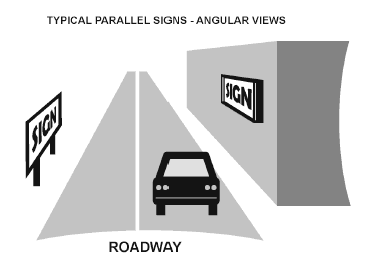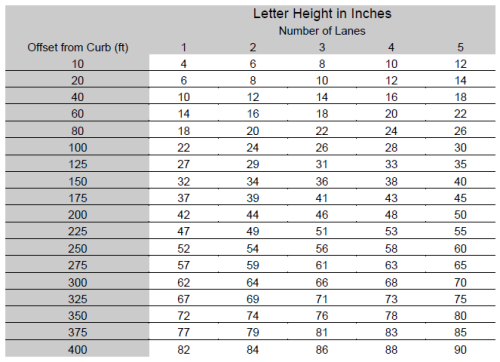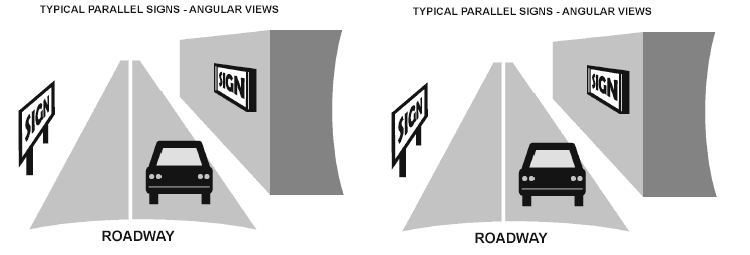How to calculate the area of an outdoor sign when placed parallel to the street or highway.
Original Question: We are designing some banners for our business, and are discussing what colors to use on them. What input can you give us regarding contrast and overall banner color design.
Part 5 will specifically deal with parallel signs. We may have slightly over-answered the question, but all of what we’ve outlined here supports the color question. All of the topics relate back to the issue of your sign being seen, so color is important, and so is the size, how fast traffic passes your business, and how much time a driver has to view your sign.
It is not difficult to imagine that parallel signs are more difficult to see than are perpendicular signs, as they’re not jumping out in front of you like the perpendicular signs do. However, imagination is worth only so much, so the USSC (United States Sign Council) set out to make scientific formulas and equations that would give us a mathematical model to work with.

It is often virtually impossible to see some signs because of their orientation, especially at longer distances, at higher speeds, and with multiple lanes of traffic. Perpendicular signs can also block visibility of parallel signs or banners. There is also a shortening and angular distortion that occurs as you approach a parallel sign, and the sign will disappear more quickly once you do make visual contact. The following illustrates how a driver might see parallel signage –
Disadvantages of Parallel Signs
As you can see from this illustration, there are three things that place a parallel sign at a disadvantage to perpendicular signs.
1. They are more difficult to read.
Because of the angle, they’re more difficult to read as the message is distorted from the front of the sign to the furthest distance the sign is from your viewing position.
2. They quickly disappear from any driver’s peripheral vision.
The sign disappears into the driver’s peripheral vision more quickly because the viewing angle is above 30 degrees, so viewing time is compressed.
3. They are outside of the cone of vision.
If the sign is set back off the street like many parallel signs are, they are significantly outside the driver’s cone of vision. When this is the case, the driver has to take quick, fraction-of-a-second sideways glances to get a glimpse of the sign. Often a driver cannot find the sign at all.
Real World On-Premise Sign Visibility Study
In the USSC study, Real World On-Premise Sign Visibility, people were asked to drive through a shopping mall parking lot and locate specific signs. Virtually all perpendicular signs were located, but about 30 percent of all parallel signs were missed completely, even though they averaged two to three times larger than the perpendicular signs. The drivers were looking for all the specified signs, but missed nearly a third of the parallel signs!
The sign Area for Perpendicular Signs is Different with Parallel Signs
Because of a parallel sign’s propensity for being overlooked, we cannot use the equations that we used for perpendicular signs to create letter height for parallel signs as they will not give the driver adequate time to see the signs. In the past 4 sections of this article, we noted that for a sign to be seen, the viewer must have a certain amount of time to react once he or she has seen the sign (VRT), and the VRT, combined with the speed at which the driver is travelling, tells us the approximate VRD (viewer reaction distance). And that we can calculate the size of sign needed using the LI, or legibility index.
All that info is out the window, so to speak, when we are forced to use a parallel sign for our business. The hope is that you can utilize both, but there are some times and places where this option is simply not available. With parallel signs, what is more important is line of sight angle as well as the ability to view the sign in successive quick glances.
The Angle of Viewing
Research has determined that the angle of this viewing should be no less than 30 degrees from the driver’s line of sight. This, with the number of lanes on the street or highway and the sign’s distance from the curb, determines the Maximum Available Legibility Distance (MALD). This is much different though, than the VRD of a perpendicular sign in that the most that one can expect from the driver is a few very quick glances without dramatically increasing the possibility of an accident.
The Size of the Sign Letters
The same research determined also that the size of the letters would need to be increased by a factor of three, then leveled off, not improving much as the size increased beyond three. Therefore, what was, on the Legibility Index (LI) as a 30 will now be a 10, and to get the same reading as a 30, it will be 30 x 3 = 90. So, then, a perpendicular sign with 17” letters at 500’ away would need to have 50” letters at 500’ if the sign’s orientation were parallel.
Parallel Sign Equations
There are two parallel sign letter height equations that can be used to determine the letter height and sign area needed for these signs.
Equation #1: LH = (LN x 10 + LO) / 5
Equation #2: LH = (LN x 10 + LO) / (LI / 6)
Variable Data:
- LH is letter height in inches.
- LN is the number of lanes of traffic.
- LO is the lateral offset from curb in feet.
- LI is the legibility index from Table 1
1. Equation #1 would work like this…
- LN = 2 Lane Road
- LO = Lateral Offset from the curb which is 37 feet
- LH = Letter Height, which for this equation is unknown but will be determined by the equation
LH = (2 x 10 + 37) / 5 so that the letter height would be 11.4”
2. Equation #2 would work like this…
- LN = 2 Lane Road
- LO = Lateral Offset from the curb which is 37 feet
- LH = Letter Height, which for this equation is unknown but will be determined by the equation
- LI = 22
LH = (2 x 10 + 37) / (22/6) so that the LH is about 15.5”
Letter Height Sizes Chart
For quick reference, the USSC has provided this chart to give you a sketch of letter sizes needed for various viewing distances and offsets.

If your sign professional does not use scientific calculations to determine how best to advertise your business, either with a permanent main ID sign or with a temporary banner advertising your upcoming sale or new service, you may want to consider finding someone who REALLY knows what they’re doing, because right now, they’re burning your money.
Popular Posts:




